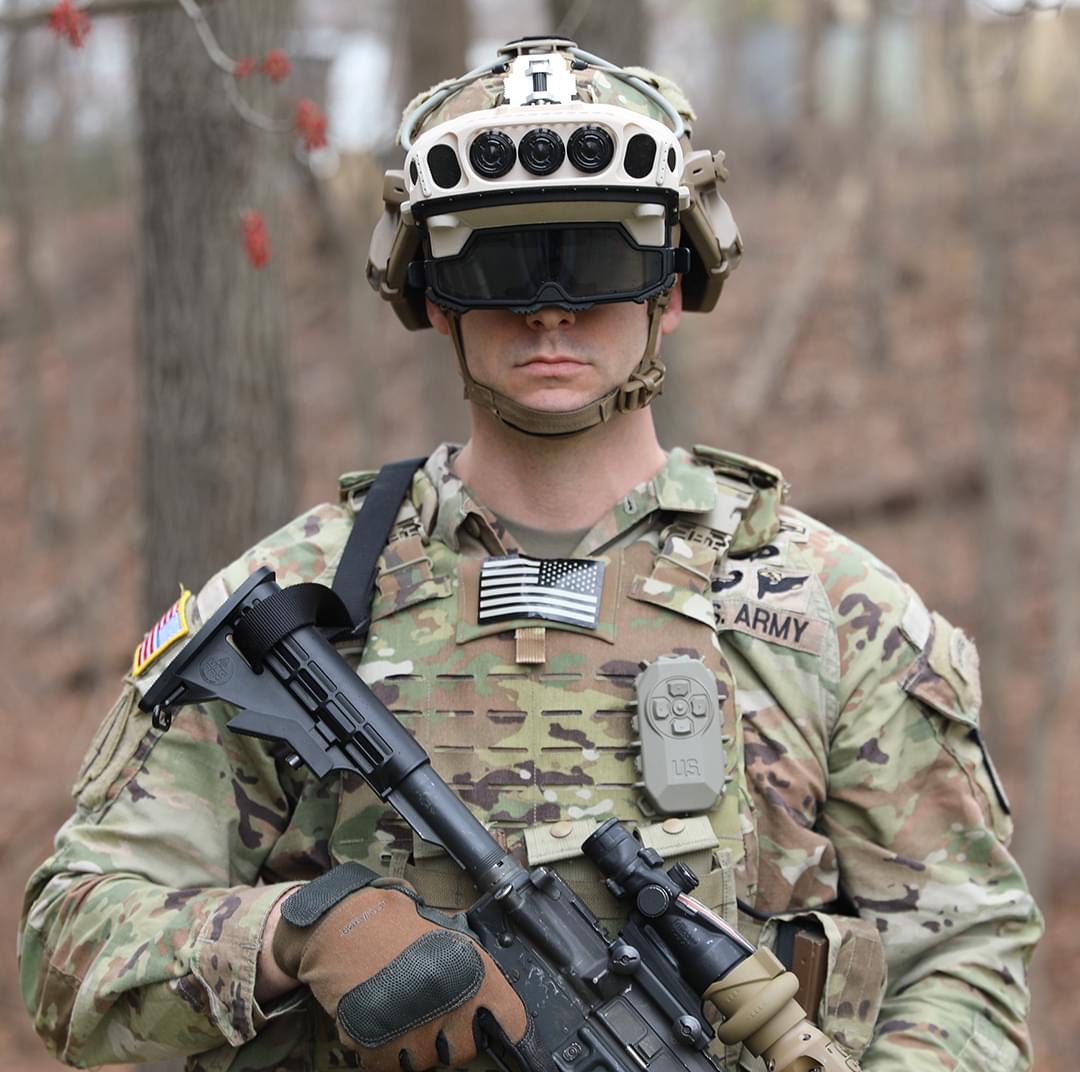
IVAS 1.2 features an improved form factor and a lower profile heads-up display with distributed counterweight for improved user interface and comfort.
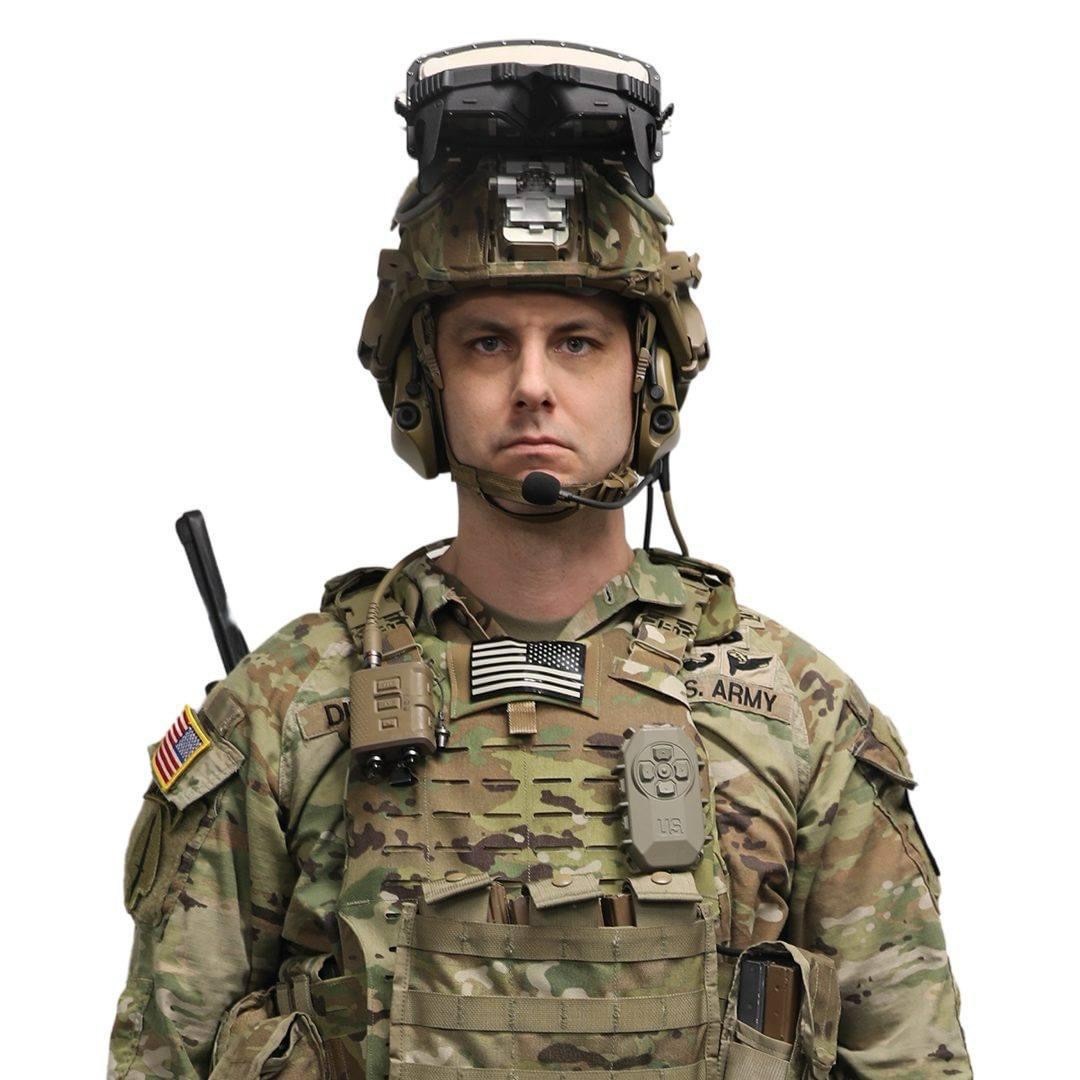

IVAS 1.2 features an improved form factor and a lower profile heads-up display with distributed counterweight for improved user interface and comfort.

Over the past year, the Army tested, evaluated and refined the Integrated Visual Augmentation System’s (IVAS) capabilities in a manner that will result in improved systems being incrementally fielded to Soldiers over the next several years – IVAS 1.0, IVAS 1.1 and IVAS 1.2 variants.
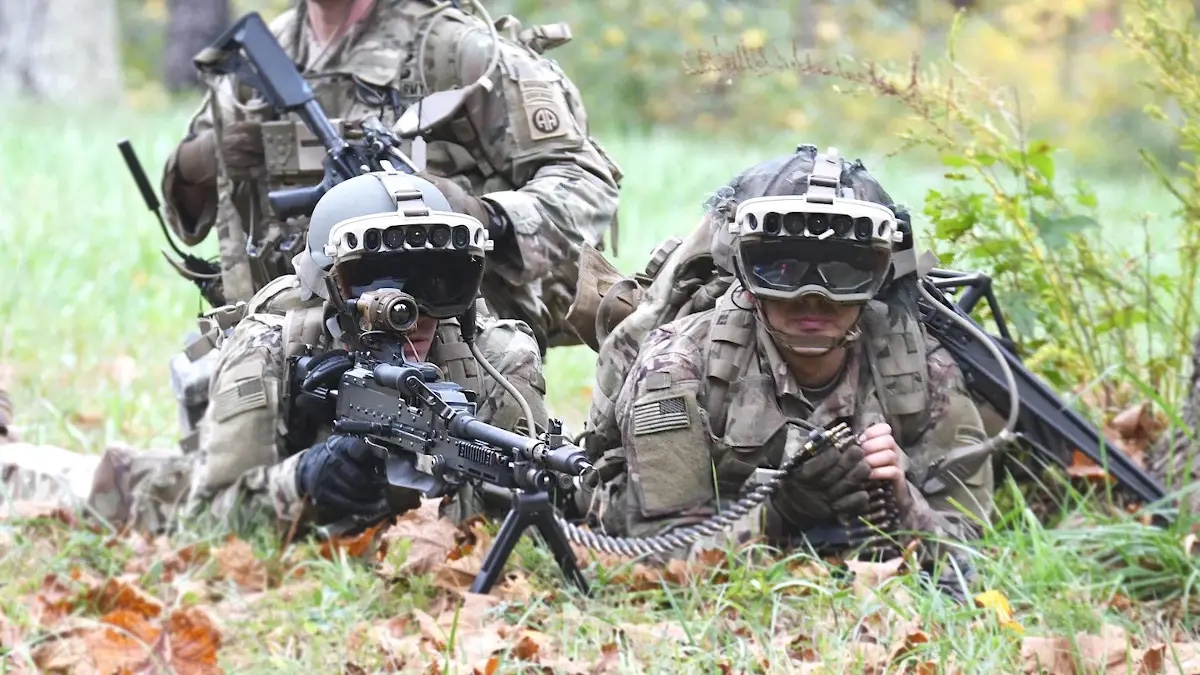
Last June, IVAS completed its Operational Test, during which Soldiers trained on IVAS 1.0 systems in company-level missions and live-fire exercises. The Army determined that IVAS demonstrated several transformational capabilities, but three areas prevented the systems from achieving Soldier acceptance: reliability, low-light sensor performance and form factor.
The Army and its industry partner, Microsoft, used the lessons learned from testing to address concerns and adjust its fielding plan. To specifically address reliability, in November 2022 Microsoft and the Army incorporated a new software release into IVAS 1.0 resulting in a more stable and reliable user experience. Software improvement is a continuous effort that will transcend all current and future versions of IVAS.
IVAS 1.0 systems will be fielded to training and doctrine units next year to support the Army’s Campaign of Learning, an ongoing process that gathers and incorporates user feedback from user studies, user assessments, Soldier Touch Points and operational demonstrations to improve IVAS’ performance.
IVAS 1.1 upgrades reliability and features an improved low-light sensor that performs comparable to the PVS-14 night vision goggles. These systems will be delivered and fielded in Fiscal Year (FY) 2024.
The Army awarded an IVAS 1.2 technology insertion effort to Microsoft in December 2022, with the anticipation of moving to production in late FY2024 and fielding to operational units beginning as early as 4Q FY2025. The majority of the close combat force will receive IVAS 1.2; this version features an improved form factor in addition to reliability and low-light sensor upgrades, as well as a lower profile heads-up display (HUD) with distributed counterweight for improved user interface and comfort.
In recent exercises the Army has shown a number of different ways IVAS can be used on the battlefield, ranging from ingesting video and data from small Unmanned Aerial Systems to integrating with ground and air platform sensors to provide Soldiers the ability to see what the platform drivers, commanders and pilots see before dismounting into a hazardous situation.
The Army remains fully committed to IVAS. Despite some revisions to the fielding timeline, the developmental process for IVAS will result in fielding several years ahead of standard acquisition programs.
By PEO Soldier PAO
Last month, the US Army began fielding an interim version of the Cold Temperature and Arctic Protection System or CTAPS to the Alaska-based 11th Airborne Division following a Directed Requirement from the Chief of Staff of the Army, General James C. McConville.
Soldier Systems Daily had the opportunity to sit down with the Program Executive Office – Soldier team behind this project to discuss how it happened. The Product Manager Soldier Clothing and Individual Equipment is LTC Naim Lee. He was joined by Assistant Product Manager for Extreme Weather Clothing and Equipment, MAJ Ryan Ogden and a Textile Technologist on his team, Mr. James Murdock who is an Engineer assigned to the Combat Capabilities Development Command Soldier Center in Natick, MA.
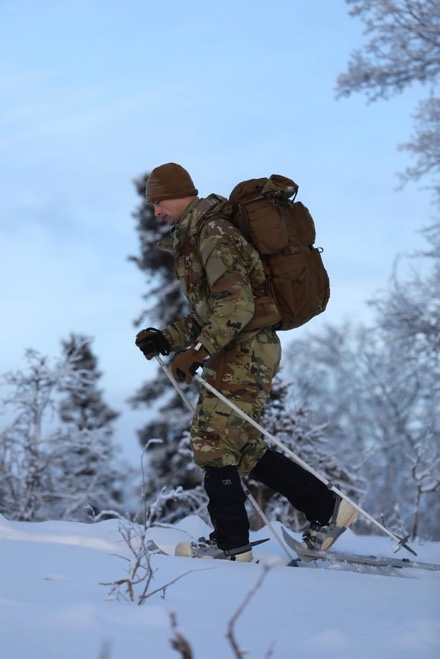
The CSA issued the Directed Requirement to provide the 11th Abn Div with an improved interim cold weather clothing capability in June 2022 and by January 2023, the team was already conducting human factors testing at the Cold Regions Test Center at Fort Greely, AK with 18 Soldiers from the 70th Brigade Engineer Battalion. The PEO Soldier team quickly transitioned from testing to fielding beginning in mid-February.
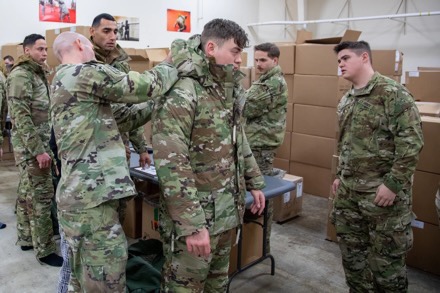
As fielded, CTAPS consists of five layers vice the seven layers of ECWCS. MAJ Ogden explained that Army hasn’t decided how they will characterize layers in the future but in the meantime will continue to use the layer designations of the Extreme Cold Weather Clothing System Generation III. However, like with ECWCS (and the similar Protective Combat Uniform worn by SOF personnel), although they are referred to as layers, the Soldier may combine different layers to gain the desired protection from the elements.
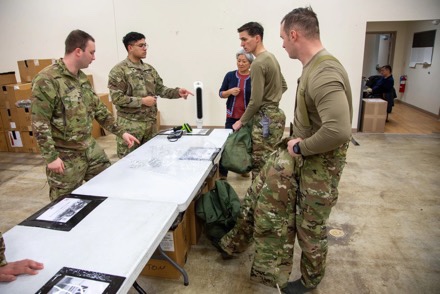
Featuring the Operational Camouflage Pattern, CTAPS is offered in 15 different sizes, ranging from extra small and short to extra-extra-large and extra-long.
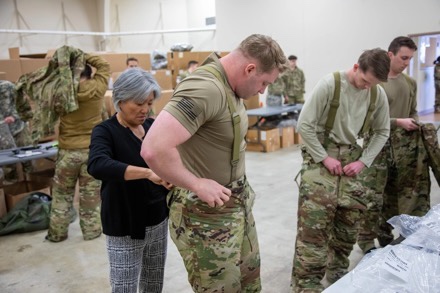
While CTAPS features government designs, two of the layers, layers one and six were fulfilled by Commercial Off The Shelf (COTS) items due to the short notice nature of the requirement.
CTAPS includes:
Layer 1 – Base layer
Layer 3 – Lightweight Insulated Liner
Layer 5 – Softshell Uniform
Layer 6 – Cold/Wet Weather Uniform
Layer 7 – Extreme Cold Weather Parka/Trousers
One of the ways that the Army is able to reduce the number of layers is by creating adaptable garments which combine capabilities. For example, the CTAPS L5 Softshell Uniform is intended to function as both Softshell and Wind Shirt found in ECWCS.
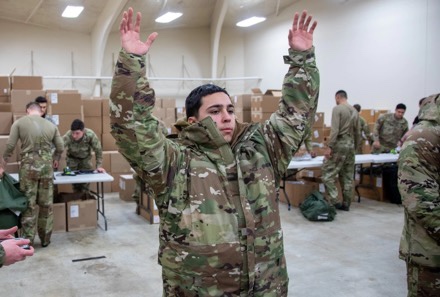
Additionally, Murdock said, “there is functionality in the designs. There is a reason every pocket and zipper is located where it is, so that the entire ensemble not only works as a system but that it also interfaces with other OCIE like body armor, gloves, boots, and head protection.”
Based on the recent Arctic strategy document, “Regaining Arctic Dominance” the Army must be capable of surviving temperatures as low as -65 deg F. This is slightly colder than the -60 deg F capability provided by ECWCS going back to its first iteration in the late 1980s. Murdock explained that although the system has been tested to -65, everyone reacts a bit differently to extreme temperatures and while one Soldier may find the ensemble just fine, another may feel cold or another warm.
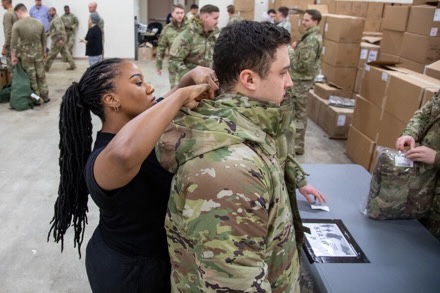
Murdock explained that the search for materials to handle such extreme temperatures began in 2016 with the Regionally Aligned Combat Ensemble – Arctic program. The Combat Capabilities Development Command Soldier Center evaluated numerous different fabrics for their individual attributes as well as how they could be combined for use in a clothing system for extreme cold weather.
They also worked with Subject Matter Experts from the Army as well as the civilian winter sports community to inform form and function. These concepts were bounced off of 11Bs in the Infantry as well as Soldiers from other branches to determine their applicability to the mission. For example, the L7 parka is now designed to be worn with armor and the trouser features an expandable waist to make it more adaptable to layering.
MAJ Ryan Ogden pointed out the short period of time it took to fulfill this requirement stating, “One of the big takeaways is the rapid flash-to-bang from requirement to fielding. We worked closely with industry to make this happen. It’s a testament to how quickly we can get a capability out to the force.” Murdock added, “We had companies working very closely with one another that might normally be seen as competitors. Everyone came together to make this happen.” This was a major event within the US textile industry. Not only did fabrics have to be milled, treated and printed, but the companies actually assembling the garments had to manage supply chains that include such disparate items as snaps, zippers, and nylon tape, with everything coming from a different supplier. Industry is currently producing up to 400 sets of CTAPS per day and as many, if not more, Soldiers are being issued their systems every day.
The units receiving the new clothing are the 1st Infantry Brigade Combat Team at Ft Wainwright and the 2nd IBCT (Airborne) at Joint Base Elmendorf-Richardson. MAJ Ogden conveyed that a small quantity of additional systems was also delivered to cover sizing tariffs and spares of two such large organizations.
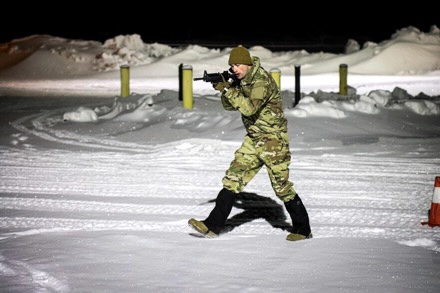
Next month, the units will participate in a force-on-force Field Training Exercise which will also serve as a testbed for the clothing systems.
LTC Lee wanted to point out that what you see here isn’t the final configuration. PEO Soldier will use information gleaned from the fielding of this directed requirement to inform a future iteration of specialized clothing to replace the current ECWCS Gen III.
Additionally, LTC Lee mentioned that accessory items like hand and footwear as well as head protection for extreme cold are separate from this project and covered under other programs of record.
The big takeaway here are that the Army can work with industry to rapidly field unique requirements at scale and that PEO Soldier continues to improve clothing and individual equipment for the Soldier.
MAJ Ogden summed it up well, “CTAPS leverages novel materials and offers increased comfort and durability, reduced bulk, enhanced integration with OCIE, and improved moisture management.”
Project Manager Soldier Survivability (PM-SSV) began the issuing of the Cold Temperature and Artic Protection Systems (CTAPS) system to two Brigade Combat Teams (BCT) of the 11th Airborne Division at Ft. Wainwright and Anchorage, AK on February 13, 2023. Soldier feedback on CTAPS will inform the Army’s next generation Cold Weather Clothing System requirement for protection in extreme cold weather operating environments, with a more modular, adaptable, and packable system.
PM-SSV in conjunction with the DEVCOM Natick Soldier Center worked tirelessly to fulfill the June 2022 Army directed requirement to outfit soldiers in Alaska in support of winter field training exercises, inform the Army long-term requirement for Arctic Clothing and provide the 11th Airborne Division with this improved interim capability.
CTAPS allows soldiers to effectively operate and sustain combat operations in extreme conditions increasing their ability to fight is temperatures as low as -65 degrees Fahrenheit.
The team transitioned the CTAPS from Science & Technology to production and began delivering CTAPS to the 11th Airborne Division within six months of receiving the Directed Requirement. This included transitioning three novel materials to production that had never been produced in large quantities by the industrial base, establishing production contracts with multiple vendors, and ramping up the entire supply chain to support this effort. Currently vendors are producing between 250-400 sets of CTAPS per day and 300-500 soldiers are being issued CTAPS every day.
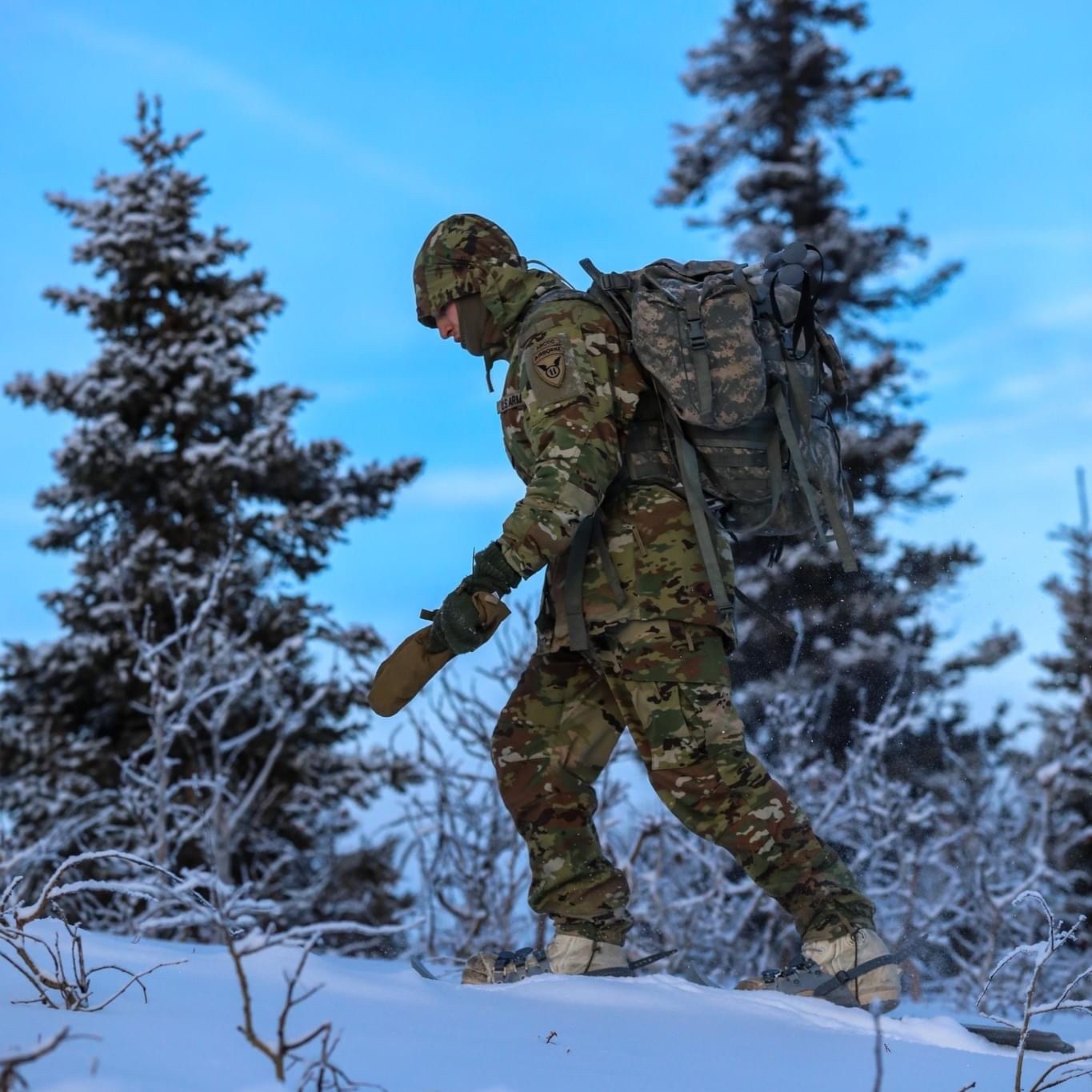
Soldiers of D Company, 70th Brigade Engineering Battalion, supporting the 11th Airborne Division, test out the new Cold Temperature and Arctic Protection System, or CTAPS, at the Cold Regions Test Center, Fort Greely, AK.
CTAPS is an innovative multi-layer system that aims to keep Soldiers warmer in cold weather environments, spanning from 45 degrees Fahrenheit to -65 degrees Fahrenheit.
Photo from PEO Soldier
Washington – On Dec. 20, 2022, the U.S. Army awarded a task order to Microsoft Corporation to develop the 1.2 variant of the Integrated Visual Augmentation System.
This task order is the latest step in the process that began in March 2021, when the Army awarded Microsoft a firm-fixed-price Other Transaction Authority production agreement to manufacture IVAS. Under that agreement, the Army envisioned improving the system through an iterative process, and this task order will provide improvements based on completed test events.
The IVAS will provide Soldiers with a single device to fight, rehearse and train by integrating next-generation situational awareness tools. To date, the Army has conducted over 30 Soldier test events and more than 100 technical sub-tests, with more than 1,000 Soldiers contributing nearly 100,000 hours of IVAS user feedback. These tests validated the system’s continued progress while identifying areas for focused improvements.
IVAS will begin incremental fielding in September 2023. IVAS 1.0 provides baseline warfighter capability, and the IVAS 1.1 features an improved low-light sensor to aid maneuver and positive target identification. In addition to the IVAS 1.1 improvements, IVAS 1.2 will include a new form factor to address Human Systems Integration, including physiological impacts identified during testing, and a lower profile heads-up display with distributed counterweight for improved user interface and comfort. IVAS 1.2 will also include software improvements for increased reliability and reduced power demand.
Delivery orders for IVAS 1.2 production systems will be placed after qualification and operational testing.
The Army will continue to work with its IVAS industry partner, Microsoft, to execute the IVAS program in a rapid and innovative manner. The iterative and Soldier feedback oriented developmental process for IVAS will result in fielding substantial capability several years ahead of traditional acquisition program timelines. The Army is fully committed to IVAS and the leap-ahead capability it will provide for Soldiers to prevail on the battlefield.
By U.S. Army Public Affairs
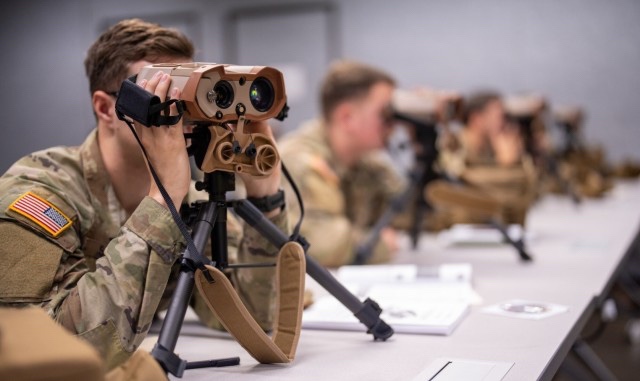
FORT CAMPBELL, Ky. — Program Executive Office Soldier concluded a four-day fielding event of the Laser Target Locator Module II, or LTLM II, units to Soldiers assigned to the 3rd Brigade Combat Team, 101st Airborne Division, with a new equipment training session on Fort Campbell, Dec. 1.
PEO Soldier personnel fielded 166 LTLM II devices and provided Soldiers training on its operations both in the classroom and outdoors in practical exercise scenarios.
“We want them to get as hands-on as possible,” said Mario Garcia, Soldier Precision Targeting Devices New Equipment Training team lead for PEO Soldier. “We also give them the training material because this is a ‘train the trainer’ course. That way, they can take that with them and build the training within their unit.”
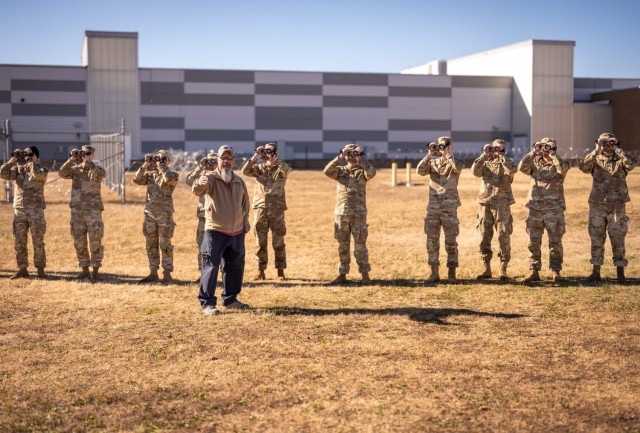
LTLM II is a second-generation lightweight, handheld laser target locator with a direct view optic, uncooled thermal camera, low-light camera, eye-safe laser range finder, digital magnetic compass, and a Selective Availability Anti-Spoofing Module GPS receiver. It provides dismounted forward observers, scouts, snipers, and platoon leaders all-weather capability to locate targets accurately and transmit target data.
LTLM II improves upon its predecessors, such as the Target Reconnaissance Infrared Geolocating Range Finder, or TRIGR, by being smaller, lighter and more user-friendly.
“The biggest difference is size and weight. With the TRIGR, we’re going from a five-and-a-half-pound system to a system that’s just over three pounds. And that’s not counting the batteries or tripod. The buttons and menus are easier to operate as well. You have less multi-functions of the buttons, which enhances ease of use. These changes were all the result of Soldier feedback,” said Garcia.
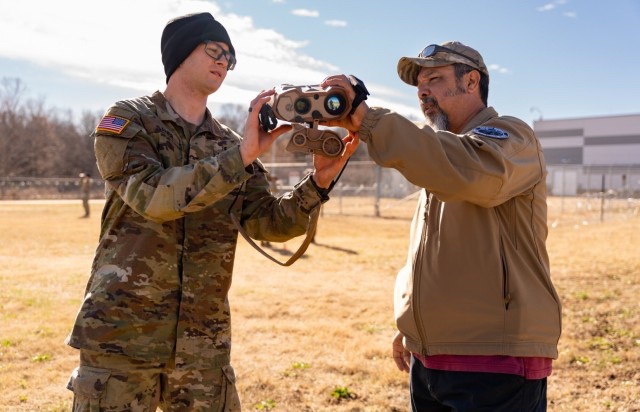
Prior to the LTLM, a single Soldier would determine the location of a target of interest by getting their self-location, finding the potential target and estimating the distance and direction of the target. Once the self-location, distance and direction to the target are found, the Soldier then would go back to their map and plot the estimated location on it and find the location.
With LTLM II, Soldiers can determine a target location in seconds and much more accurately. Soldier feedback following the hands-on training was positive and many look forward to using LTLM II in the field.
“I think this device is going to be really good to integrate into dismounted reconnaissance teams,” said a Soldier assigned to the 3rd Brigade Combat Team, 101st Airborne Division. It has good thermal capabilities and picture quality, so we’ll be able to deliver really good information to our commander and send that up immediately. The only thing we have that’s comparable to this right now is the AN/PAS-13 (thermal weapon sight) and as a tool this is 20 times better.”
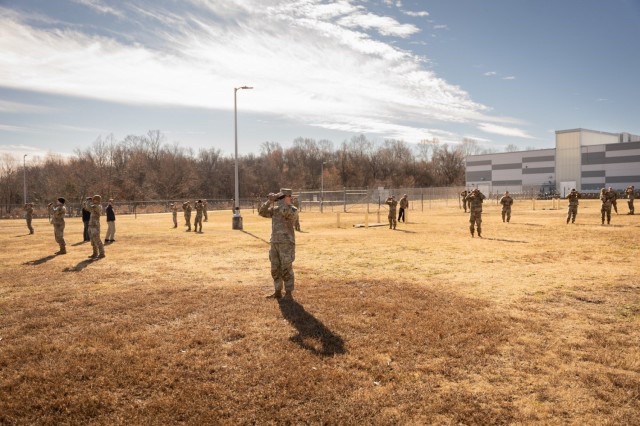
In addition to fielding more than 160 units, PEO Soldier personnel were also able implement a software update that allows LTLM II’s fielded prior to September 2021 to communicate with the Precision Fires-Dismounted system. LTLM II’s fielded after September 2021 already have the software installed.
“We conducted software updates on systems previously fielded to 1st Brigade Combat Team, 101st Airborne Division while we were here doing this fielding with the 3rd Brigade. The update allows the device to also communicate with the PFD in addition to the Defense Advanced GPS Receiver and Pocket-sized Forward Entry Device. In the event I’m targeting something, instead of having to read off the screen, it’ll send the targeting data to whatever device I’m using, and I can send that digitally to wherever it needs to go,” said Garcia.
By Jason Amadi
During this week’s Future Force Capabilities Conference presented by the National Defense Industrial Association in Austin, Texas, Program Manager Soldier Lethality COL Scott Madore briefed the audience on changes to his PM’s structure.
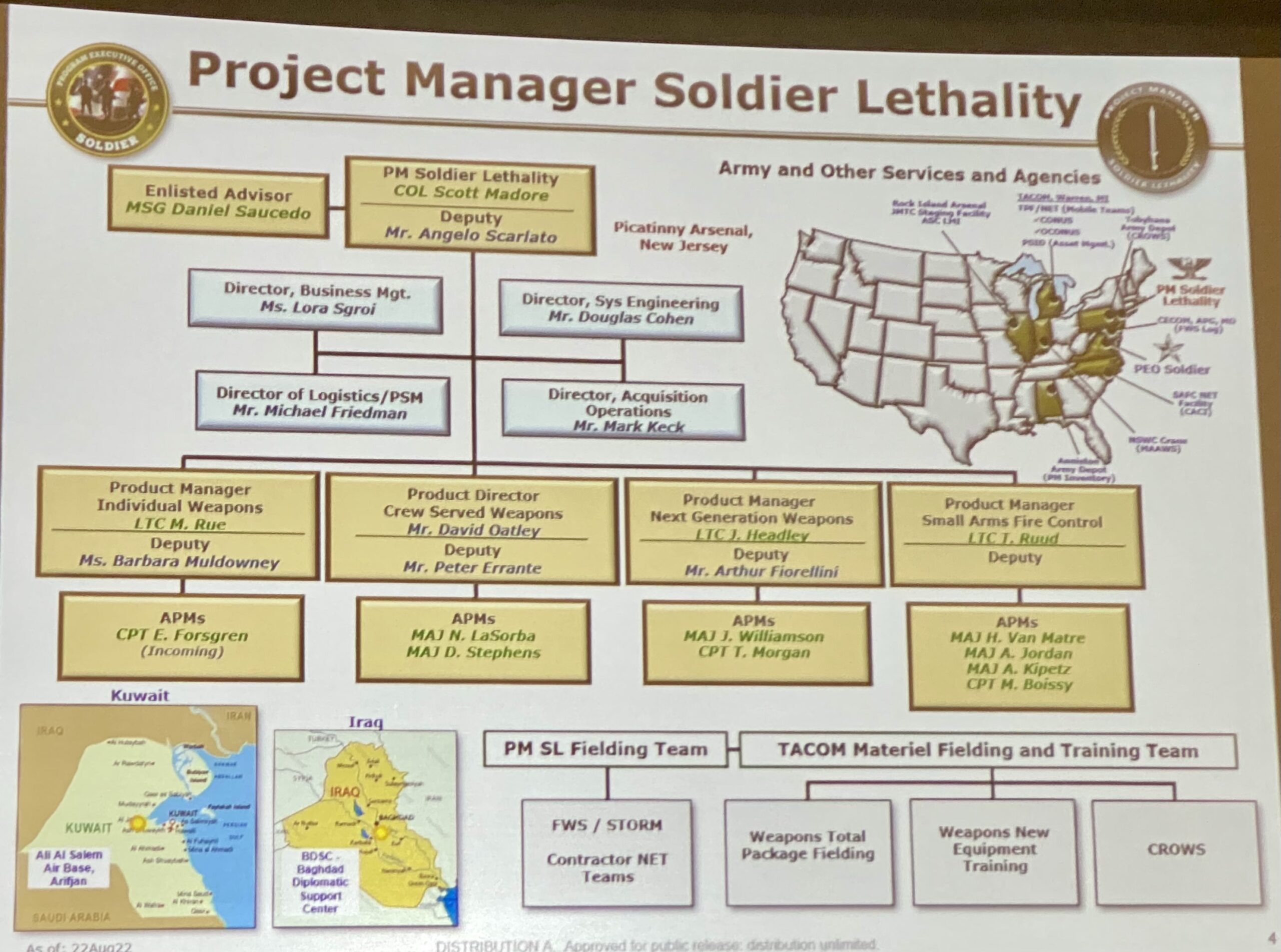
The structure of PEO Soldier has undergone several changes over the past few years and part of Reorg Phase III was to stand up PM Small Arms Fire Control (SAFC). SAFC is responsible for Family of Weapon Sights, Small Tactical Optical Rifle Mounted (STORM) sights, and the XM157 Next Gen Squad Weapon Fire Control (NGSW-FC).
Transitioning several program from PM Soldier Sensors and Lasers, PM SAFC will continue operations at Ft Belvoir, VA and NGSW-FC will remain at Picatinny Arsenal, NJ.
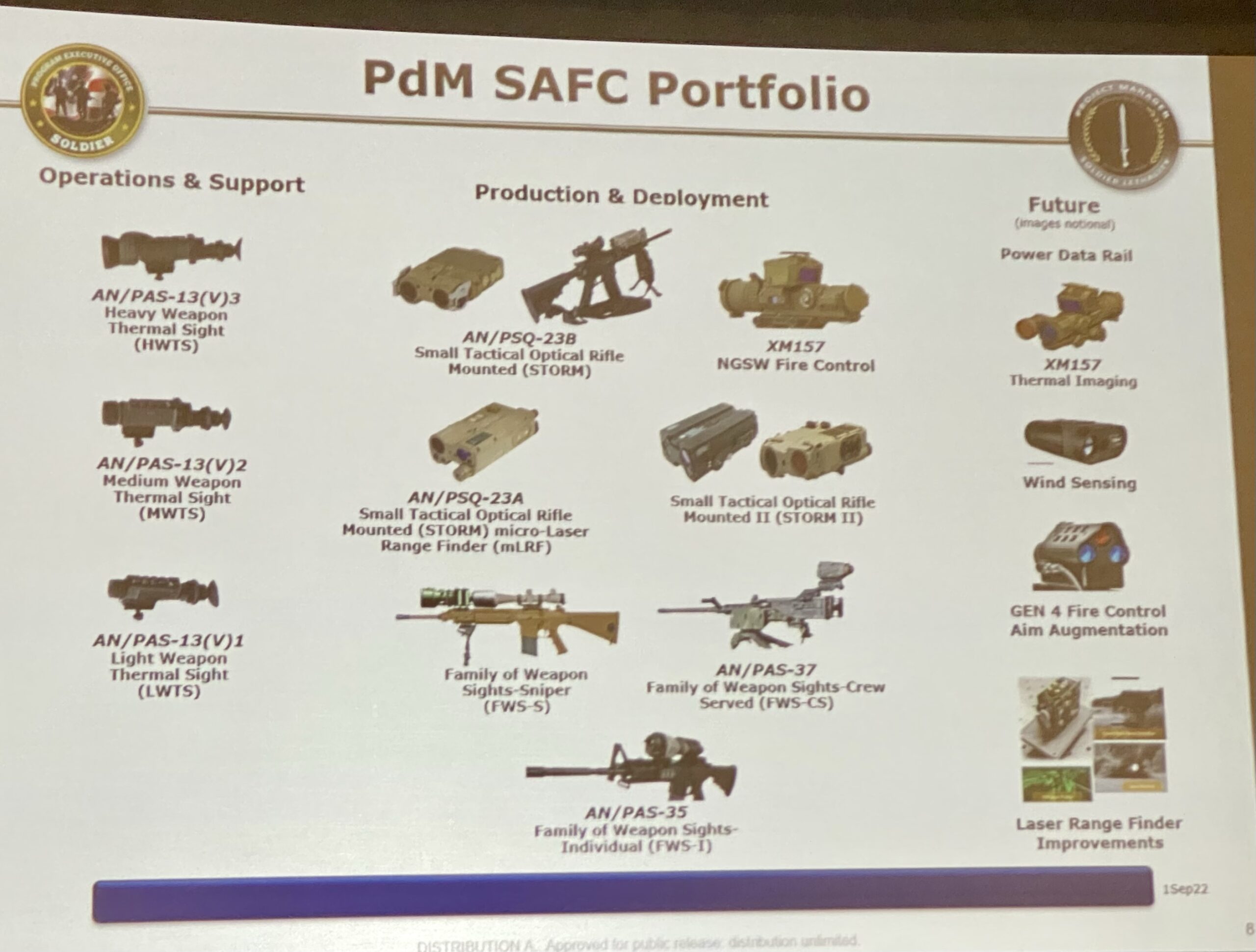
With the addition of PM SAFC, PM-SL is now has responsibility for the full life cycle of small arms, including enablers.